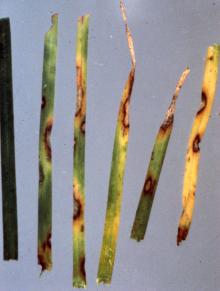See:
Grass for Seed - Drechslera Leaf Blights (Helminthosporium Net Blotch)
Hosts Primarily perennial ryegrass and some fine fescues, but other grasses may be affected.
Cause Pyrenophora lolii (formerly Drechslera siccans) causes a foliar disease also referred to as winter brown blight. This fungus survives unfavorable conditions in infected plants and plant debris. Leaf infections are most common in cooler months. Conidia spread by wind, splashing rain, grass clippings, or by equipment. Generally worse on young stands in their first autumn and on turf with low nitrogen fertility.
Symptoms Tiny, chocolate-brown spots to large, dark-brown streaks up to 0.4-inch long appear on perennial ryegrass leaves. Girdled leaves become yellow and die back from the tip. The stand turns brown, becomes thin, and looks drought stressed.
Cultural control
- Maintain vigor with increased nitrogen. Avoid low nitrogen in the fall.
- Plant mixtures containing hard fescues.
Chemical control Not recommended for home lawns because the disease rarely kills grass. For high-maintenance turf, begin scouting for the disease in early winter. Note: Avoid using fungicides containing Group 1 fungicides (such as Cleary's 3336 or OHP 6672) on affected lawns because they can increase the severity of the disease. Also, to prevent developing resistant fungi, alternate or tank-mix materials from different groups with different modes of action. Limit the use of any one group during crop production.
- Chipco 26019 FLO at 3 to 4 fl oz/1,000 sq ft. Group 2 fungicide. 12-hr reentry.
- Compass 50 WDG at 0.1 to 0.25 oz/1,000 sq ft. Do not use organosilicate additives. Group 11 fungicide. 12-hr reentry.
- Daconil Weather Stik at 2 to 5.5 fl oz/1,000 sq ft depending on whether the application is preventive or curative. Group M5 fungicide. 12-hr reentry.
- Eagle 20 EW at 1.2 fl oz/1,000 sq ft. May produce a growth regulation effect on Kentucky bluegrass. Group 3 fungicide. 24-hr reentry.
- Fame SC at 0.2 to 0.4 fl oz/1,000 sq ft. Group 11 fungicide. 12-hr reentry.
- Heritage at 0.2 to 0.4 oz/1,000 sq ft. Group 11 fungicide. 4-hr reentry.
- Insignia SC at 0.4 to 0.7 fl oz/1,000 sq ft. Do not use with organosilicate adjuvants. Group 11 fungicide. 12-hr reentry.
- Mancozeb 80% (Fore, Manzate, and Protect DF) at 4 oz/1,000 sq ft. Group M3 fungicide. 24-hr reentry.
- Medallion SC at 1 to 2 fl oz/1,000 sq ft. Apply after mowing. Use with oils or adjuvants may cause plant damage. Group 12 fungicide. 12-hr reentry.
- Previa at 2 to 5.5 fl oz/1,000 sq ft. Group M5 fungicide. 12-hr reentry.
- Propiconazole-based products. Group 3 fungicides.
- Banner MAXX at 1 to 2 oz/1,000 sq ft. 12-hr reentry.
- PropiMax EC at 0.37 to 0.73 fl oz/1,000 sq ft. 12-hr reentry.
- Secure at 0.5 fl oz/1,000 sq ft. Group 29 fungicide. Reentry when sprays have dried.
- Trinity at 0.5 to 2 fl oz/1,000 sq ft. Group 3 fungicide. Do not mix with growth regulators during hot weather as injury may develop.12-hr reentry.
- Velista at 0.3 to 0.5 oz/1,000 sq ft. Group 7 fungicide. 12-hr reentry.
Combination Fungicides
- Encartis at 3 to 4 fl oz/1,000 sq ft. Do not use with oil-based pesticides. Group 7 + M5 fungicide. Reentry when sprays have dried.
- Headway at 1.5 to 3 fl oz/1,000 sq ft. Do not use with silicone-based surfactants or EC formulations. Group 3 + 11 fungicide. 12-hr reentry.
- Heritage Action at 0.2 to 0.4 oz/1,000 sq ft. Alternate with other fungicides. Group 11 + P1 fungicide. 12-hr reentry.
- Honor at 0.55 to 1.1 oz/1,000 sq ft. Do not use with organosilicone-based adjuvants. Group 7 + 11 fungicide. Golf course turf only.
- Lexicon at 0.34 to 0.47 fl oz/1,000 sq ft. Group 7 + 11 fungicide. 12-hr reentry.
- Navicon at 0.7 to 0.85 fl oz/1,000 sq ft. Group 3 + 11 fungicide. 12-hr reentry.
- Pillar G at 3 lb/1,000 sq ft. Group 3 + 11 fungicide. 12-hr reentry.
- Tartan at 1 to 2 fl oz/1,000 sq ft. Group 3 + 11 fungicide. 12-hr reentry.
Reference Smiley, R.W., Dernoeden, P.H., and Clarke, B.B. 2005. Compendium of Turfgrass Diseases. 3rd edition. St. Paul, MN: APS Press.


